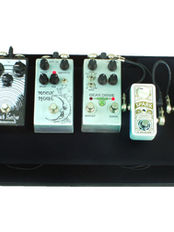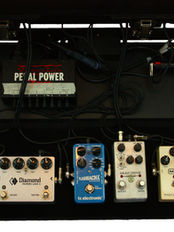top of page
PRE-FLIGHT BRIEFING
ATTACHING PEDALS TO YOUR BOARD
Flightline pedalboards are covered in a fabric specifically designed to mate with standard hook (think velcro) fastening material. To attach a pedal start by adhering a 0.5in wide strip of hook material across the top and bottom edges of the back of the pedal. DO NOT COVER THE ENTIRE BOTTOM SURFACE WITH HOOK MATERIAL! This is overkill and will make it extremely difficult to remove your pedal. Furthermore, the connection is so strong that you risk damaging the deck during removal. After applying the hook material, simply push the pedal down firmly onto the deck and slightly twist back and forth to achieve a good mecahnical bond. NOTE: If you feel that 2 strips of material is not enough, additional strips should be added along the other edges. Only use as much hook as needed to secure your pedal. Any more than necesarry only increases risk of damage to your board.
REMOVING OR RE-POSITIONING PEDALS
When you wish to remove or re-position a pedal it's important gently break it's connection to the board to avoid damage to the fabric covering. The best way to break the connection is by using something like a credit card, driver license or even a thin kitchen spatula as a release tool. While lifting gently on the pedal, work your release tool side to side between the strip of hook and the board at the side nearest to you. Once you've broke one edge of the pedal free from the board, gently tip the pedal forward while working the remaining edge free with your tool. Using this method will ensure long life of the pedal deck.
ACCESSING THE LOWER COMPARTMENT
The upper deck of all flightline pedalboards is hinged and may be lifted open to access the lower compartment. To open, place both hands under the top deck and lift upwards. Once the latches release swing the deck all the way up until it stops. It will hold itself in the open position. To close, hold the deck with both hands and lower the it all the way down. Once it's resting closed push down with your thumbs on the lower corners to engage the latches. BE CAREFUL - the upper deck will slam shut hard if allowed to drop on it's own.
USING THE 1/4" TRS LOCKING JACKS
The locking 1/4 TRS jacks mounted on either side of the board are non-directional and may be used for connecting mono or stereo devices. Typically, your instrument would connect to the right side jack and the left jack would be used for output to an amplifier, mixer, DAW or even a 2nd pedalboard for a more extensive setup. To connect a cable simply insert the plug until it's fully seated like any other instrument jack. To unplug the cable, depress the red button with your thumb before pulling outwards. The plug should release easily. If the plug does not release easily DO NOT continue pulling harder. While still depressing the red button, try pushing the jack in and out a few times while twisting the plug. It should eventually release.
build your board
step 1 - layout your pedals
The first step when setting up your new board is to decide on your pedal layout and do a test fit. This step involves a bit of trial and error. Take your time and think about how and when you use each pedal. The order of your signal flow does not have to match the layout on the board. Keep in mind that your signal and power cable jacks take up space that needs to be accounted for during this step. TIP: if your pedals already have hook material on them place a few sheets of paper on the board or some masking tape on the bottoms of the pedals to prevent them from sticking while you're laying things out. Once you've settled on a layout snap a pic for later reference.
steP 2 - MOUNT YOUR POWER SUPPLY
The compartment below the upper deck is the ideal place to mount a power supply and always-on pedals like buffers. Mount your power supply to the floor of the compartment using hook and loop, dual-lock or screws. Ensure that the deck hinges will fully clear your supply and associated cables when the deck is closed. Once your power supply is mounted plug it into the power jack. NOTE: Unplug your pedalboard from mains power any time you are performing setup or maintenance.
STEP 3 - patch cables
For connecting your pedals together you will need a series of patch cables. Ideally each cable would be custom built to reduce the amount of excess cable that needs to be managed. However, it is entirely acceptable to use off the shelf patch cables to wire your board. The beauty of the lower compartment is that you have plenty or space down there to stow any excess and have an extremely clean board board on top.
STEP 4 - mount your pedals
Once you've got patch cables sorted out you can go ahead and stick each pedal down to the board while you simultaneously connect your patch cables and power supplies.
STEP 5 - tidy up your wires
The last step is to secure all of your excess cables and tidy everything up. Hook up your power cable, plug in your instrument, switch on the board and admire your work.
gallery
bottom of page







